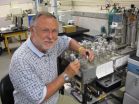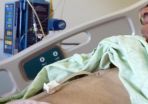Back pain improves in first 6 weeks but lingering effects at 1 year
2012-05-15
(Press-News.org) For people receiving health care for acute and persistent low-back pain, symptoms will improve significantly in the first six weeks, but pain and disability may linger even after one year, states a large study published in CMAJ (Canadian Medical Association Journal).
Low-back pain is a common condition that results in significant health care costs, disability and absenteeism in workplaces. However, there are differing views on how quickly and completely people recover from this condition.
Researchers from Australia and Brazil examined data from 33 studies (11 166 participants) to understand the clinical course of pain and disability in people receiving care for low-back pain. The study looked at more studies than previous reviews, which allowed more precise estimates of the clinical course of acute low-back pain as well as persistent low-back pain.
"Our review confirms the broad finding of previous reviews that the typical course of acute low-back pain is initially favourable: there is a marked reduction in mean pain and disability in the first six weeks," comments Dr. Christopher Maher, Director, Musculoskeletal Division, The George Institute for Global Health, The University of Sydney, Australia. "Beyond six weeks, improvement slows and thereafter only small reductions in mean pain and disability are apparent up to one year."
At one year, the patients who initially presented with acute low-back pain still experienced some pain and disability but it was minimal; the typical improvement in pain intensity was about 90%. In contrast, those who initially presented with persistent low-back pain experienced moderate levels of pain and disability at one year; the typical improvement in their pain was only about 50%.
Maher notes, "There is both good and bad news in our review. It is great that people improve with care, but arguably there is room to do better, particularly for people with persistent low-back pain. Generally, when people see results like this they want to blame the clinician, but I think that is short-sighted. One of the principal reasons we have not made more progress in the back pain field is that research agencies do not take back pain research seriously.
Around the world, back pain research is hugely underfunded relative to the burden of the disease. It's time for that to change."
INFORMATION:
A related commentary is also available http://www.cmaj.ca/site/press/cmaj120627.pdf.
END
ELSE PRESS RELEASES FROM THIS DATE:
2012-05-15
Managing adult obesity is challenging for primary care physicians, but a new review published in CMAJ (Canadian Medical Association Journal) aims to provide an evidence-based approach to counselling patients to help them lose weight and maintain weight loss.
"Even though evidence suggests that patients are considerably more likely to lose weight when they are advised to do so by their primary care physicians, most patients who are clinically obese do not receive weight-loss counselling in primary care," writes Dr. Gilles Plourde, Cliniques Médicales de Nutrition et d'Amaigrissement ...
2012-05-15
A clinical study of 30 adult patients with multiple sclerosis (MS) at the University of California, San Diego School of Medicine has shown that smoked cannabis may be an effective treatment for spasticity – a common and disabling symptom of this neurological disease.
The placebo-controlled trial also resulted in reduced perception of pain, although participants also reported short-term, adverse cognitive effects and increased fatigue. The study will be published in the Canadian Medical Association Journal on May 14.
Principal investigator Jody Corey-Bloom, MD, PhD, ...
2012-05-15
If your parents have a history of high blood pressure, you can significantly reduce your risk of developing the disease with moderate exercise and increased cardiovascular fitness, according to new research in the American Heart Association's journal Hypertension.
In a study of more than 6,000 people, those who had a parent with high blood pressure but were highly fit had a 34 percent lower risk of developing high blood pressure themselves, compared to those with a low-fitness level who had the same parental history.
"Understanding the roles that family history and ...
2012-05-15
STANFORD, Calif. — What goes bump in the night? In many U.S. households: people. That's according to new Stanford University School of Medicine research, which found that about 3.6 percent of U.S. adults - or upward of 8.4 million - are prone to sleepwalking. The work also showed an association between nocturnal wanderings and certain psychiatric disorders, such as depression and anxiety.
The study, the researchers noted, "underscores the fact that sleepwalking is much more prevalent in adults than previously appreciated."
Maurice Ohayon, MD, DSc, PhD, professor of ...
2012-05-15
INDIANAPOLIS -- Current colorectal cancer screening guidelines for individuals with first-degree relatives with precancerous colon polyps are based on studies that were not properly designed or were too limited to shape those guidelines, according to a new systemic review of research on the topic. The review authors call for new studies to measure the risk and identify the factors that modify it.
"We found that most studies that are cited for the risk for colorectal cancer when first-degree relatives -- parents, siblings or children -- have a precancerous polyp do not ...
2012-05-15
SALT LAKE CITY, May 14, 2012 – If the world's nations ever sign a treaty to limit emissions of climate-warming carbon dioxide gas, there may be a way to help verify compliance: a new method developed by scientists from the University of Utah and Harvard.
Using measurements from only three carbon-dioxide (CO2) monitoring stations in the Salt Lake Valley, the method could reliably detect changes in CO2 emissions of 15 percent or more, the researchers report in the online edition of the Proceedings of the National Academy of Sciences for the week of May 14, 2012.
The method ...
2012-05-15
Despite an unprecedented rate of economic growth, Chinese people are less happy overall than they were two decades ago, reveals timely new research from economist Richard Easterlin, one of the founders of the field of "happiness economics" and namesake of the Easterlin Paradox.
In 1990, at the beginning of China's economic transformation, a large majority of Chinese people across age, education, income levels, and regions reported high levels of life satisfaction. Sixty-eight percent of those in the wealthiest income bracket and 65 percent of those in the poorest income ...
2012-05-15
Anthropologists working in southern France have determined that a 1.5 metric ton block of engraved limestone constitutes the earliest evidence of wall art. Their research, reported in the most recent edition of the Proceedings of the National Academy of Sciences, shows the piece to be approximately 37,000 years old and offers rich evidence of the role art played in the daily lives of Early Aurignacian humans.
The research team, comprised of more than a dozen scientists from American and European universities and research institutions, has been excavating at the site ...
2012-05-15
PROVIDENCE, R.I. [Brown University] — A new study led by Brown University researchers reports that percutaneous endoscopic gastric (PEG) feeding tubes, long assumed to help bedridden dementia patients stave off or overcome pressure ulcers, may instead make the horrible sores more likely to develop or not improve.
The analysis of thousands of nursing home patients with advanced dementia appears in the May 14 edition of the Archives of Internal Medicine.
"This study provides new information about the risks of feeding tube insertion in people with advanced cognitive impairment," ...
2012-05-15
What is the connection, if any, between sudden cardiac death and people with HIV/AIDS? And can that knowledge help prolong their lives?
In a comprehensive, 10-year UCSF study, researchers found patients with HIV/AIDS suffered sudden cardiac death at a rate four times higher than the general population.
"As part of my ongoing research in 2010, we were looking at every instance of sudden death in San Francisco," said first author Zian H. Tseng, MD, an electrophysiologist and an associate professor of medicine in the UCSF Division of Cardiology. "I noticed that many of ...
LAST 30 PRESS RELEASES:
[Press-News.org] Back pain improves in first 6 weeks but lingering effects at 1 year



